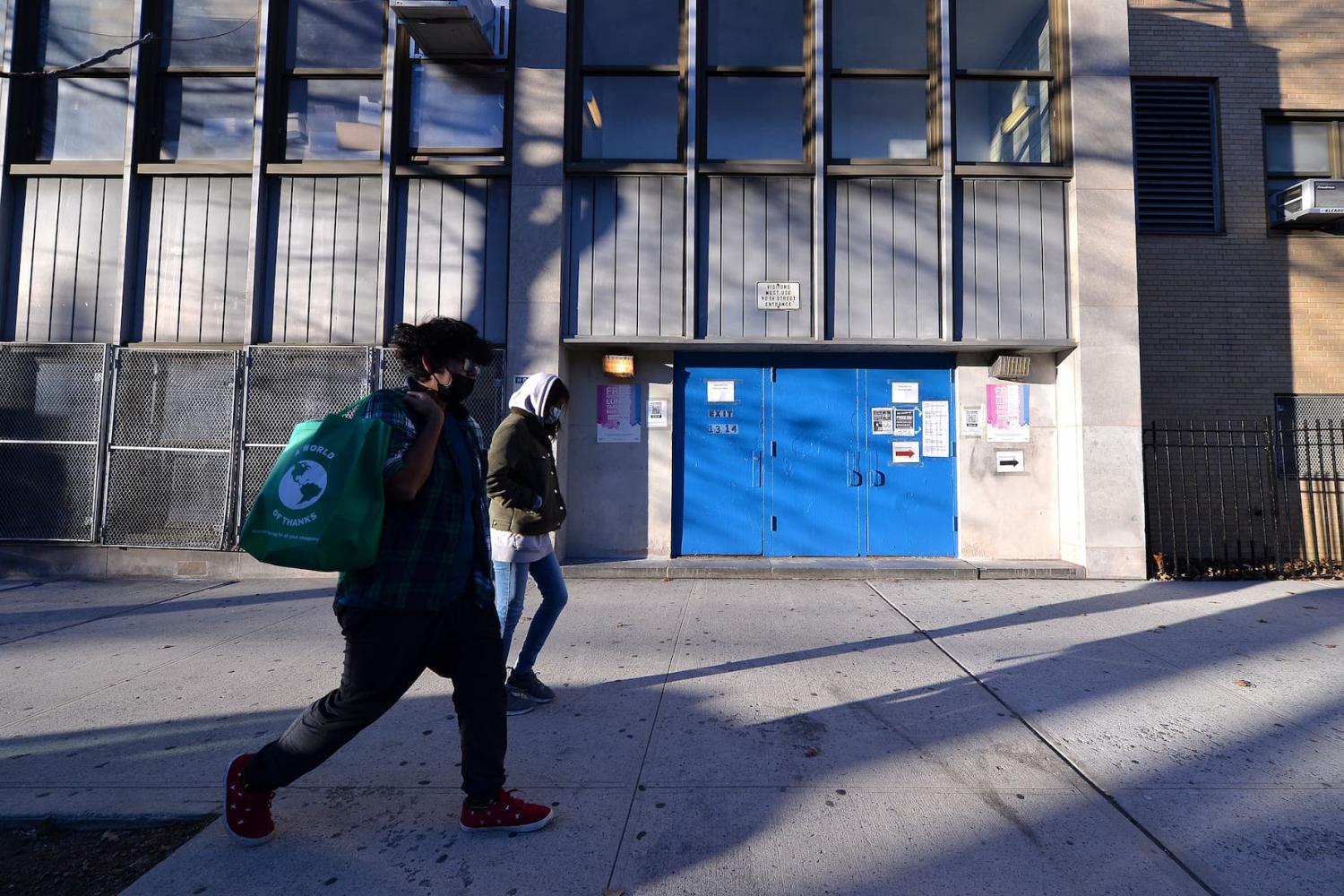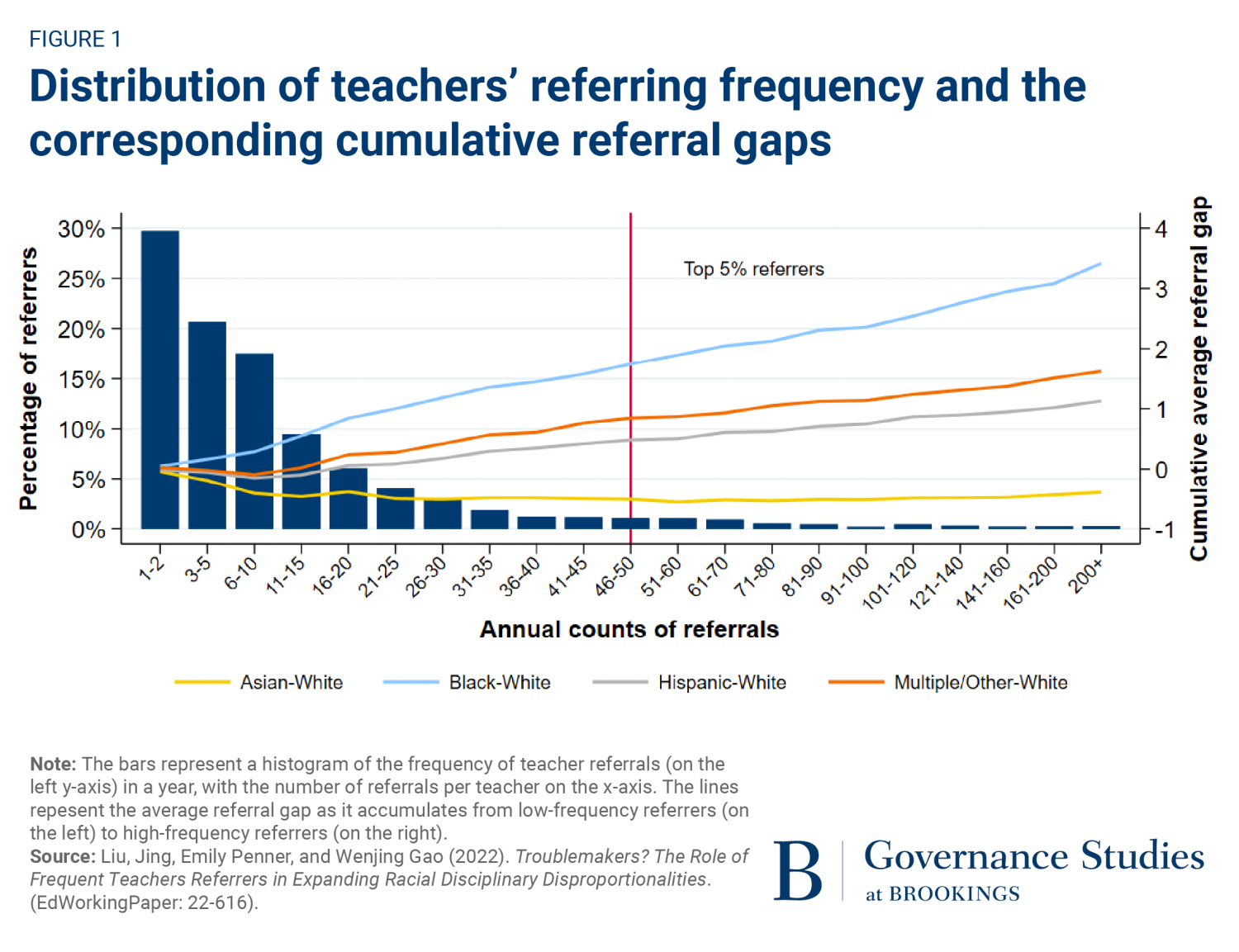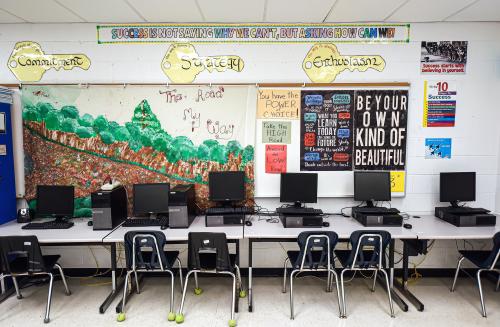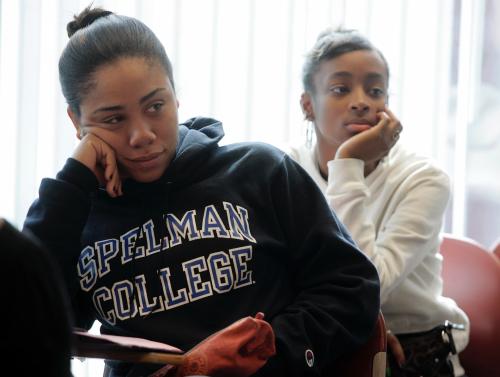Racial disciplinary disproportionalities are a stubborn feature of U.S. public school systems. Based on the 2017-18 Civil Rights Data Collection, Black students comprised 15% of public school enrollment but accounted for 38% of total suspensions.
These discrepancies are particularly troubling for two broad reasons. First, suspensions are associated with a host of negative impacts on academic achievement, school engagement, and even outcomes in young adulthood (e.g., exposure to the criminal justice system, SNAP receipt, and college completion). Second, such disparities might reflect systematic biases in how schools handle student discipline and not underlying racial differences in student behavior.
Closing racial gaps in suspensions and reducing the use of suspensions in general thus has been a priority in U.S. education policymaking. The good news is that there has been much progress in recent years. The out-of-school suspension rate dropped from 6.9% of students in 2010 to 3.8% in 2018. Many states and districts have gone through discipline reforms that limit the use of suspensions for minor infractions and adopt nonpunitive strategies such as restorative justice. For example, California banned suspensions and expulsions of students in grades k–3 for minor misbehaviors, and Massachusetts requires schools to first use alternative forms of discipline, such as mediation and behavioral intervention, before considering out-of-school suspension as a last resort.
“It is these ‘moment-by-moment’ interactions that ultimately lead to the observed racial disparities in school discipline.”
Despite these positive changes, however, racial disproportionality in school discipline persists. Why is it so hard to close such gaps? What are we missing? A close look at research articles and policy debates on this topic suggests that researchers and policymakers have been almost exclusively focusing on the end result of discipline—suspensions. In contrast, little attention has been given to the referral and reporting process that precedes the decision of whether, and for how long, to suspend a student. Educators have a great deal of autonomy about whether and how to respond to undesired student behaviors. It is these “moment-by-moment” interactions that ultimately lead to the observed racial disparities in school discipline. Thus, a deeper understanding of this referral-to-suspension process is a prerequisite for the design of programs and policies to reduce disciplinary rates and disparities.
New Research from California
In a trio of studies, my coauthors and I investigate how the referring process and actions of educators expand racial disparities in school discipline. To do this, we use four years of administrative data (2016-17 to 2019-20) from a large and demographically diverse urban school district in California. What’s unique about these data is that they contain detailed information on all disciplinary referrals, regardless of whether they ultimately led to a suspension, as well as the individual who made and received the referral, the reason for the referral (i.e., type of incident), and the exact time, date, and location of the incident. These rich details allow us to depict a fuller picture of how racial disparities in school discipline emerge.
Finding #1: Both racial gaps in disciplinary referrals and systematic biases in the adjudication processes contribute to racial disparities in suspensions
In the first study of this series, we find that Black students are more than twice as likely to have received at least one disciplinary referral as their white peers in the same school. Thus, part of the racial gap in suspensions is due to underlying differences in the frequency of disciplinary referrals. However, the racial gap in referral propensities is not the sole reason for the racial gap in suspensions. We also find that the conversion rate of referrals into suspensions across all types of referrals is significantly higher for Black than for white students even after controlling for a battery of student characteristics, including their demographics, neighborhood conditions, and their prior achievement and behavioral outcomes (47% higher relative to the base rate of 0.038 for white students).
“We find a clear and consistent pattern in which Black and Hispanic students are punished more severely than white students who were involved in the same incident and had the same prior disciplinary histories.”
The elevated referral-to-suspension conversion rate for Black students could be driven by differences in student behavior, educators’ biases, or both. But it is challenging to tease out the mechanism because researchers almost never observe the underlying student behavior of an infraction. To more rigorously test whether racial bias or “intentional discrimination” exists in sentencing decisions, we compare the outcomes for students of different races who were involved in the same incident. We find a clear and consistent pattern in which Black and Hispanic students are punished more severely than white students who were involved in the same incident and had the same prior disciplinary histories. Specifically, Black students were about two percentage points more likely to be suspended than white students involved in the exact same incident (nearly doubling the base rate of 2.6% for white students). Thus, intentional discrimination appears to explain a nontrivial share of racial disciplinary disparity.
Finding #2: A small number of teachers account for a large share of the overall disciplinary referrals, suspensions, and racial discipline disparities
Motivated by the importance of the referral process identified in the first paper, we start to look closely at teachers’ referring behavior and its association with racial disciplinary gaps in our second study. We find large variation in how many disciplinary referrals a teacher issues and that some teachers’ referring frequency is extensive. Figure 1 represents referring teachers and the effect of those referrals in two dimensions. First, the bars represent a histogram of the frequency of teacher referrals (on the left y-axis) in a year, with the number of referrals per teacher on the x-axis. As Figure 1 shows, most teachers refer few students for discipline: About fifty percent of unique teachers in the sample issued five or fewer referrals per year. But this distribution is strongly skewed, and the top 5% of referrers (those to the right of the reference line) issued over 45 referrals per year. This amounts to roughly one referral every four school days. That is several times greater than their average-referring colleagues (less than one referral for every two months of school).
While only 72 teachers are ever “top referrers” in our sample, they accounted for 34.8% of all referrals made in the four-year period. More importantly, “top referrers” effectively double the Black-white, Hispanic-white, and multiracial/other-white referral gaps. This is illustrated in the second dimension of Figure 1, where the lines represent the average referral gap as it accumulates from the low-frequency referrers (on the left) to the high-frequency referrers (on the right). These racial gaps grow significantly for the highest-referring teachers. Among teachers with fewer than 46 referrals, Black students receive 1.6 more referrals than white students on average. Once we include “top referrers”, the gap jumps to around 3.4 more referrals than white students. A closer look at the widened referral gaps by “top referrers” suggests that they are driven by high numbers of referrals due to interpersonal offenses and defiance, which are considered more subjective than other referral reasons such as violence.
Finding #3: Same-race teachers significantly reduce students’ likelihood of receiving a disciplinary referral
But which teachers are more likely to make disciplinary referrals? And which students are teachers referring? To address the question of who refers whom, in the third study, we focus on the question of how having a teacher of the same race affects a student’s likelihood of receiving a disciplinary referral. To do this, we link students and teachers through class rosters.
Consistent with a large literature that suggests same-race teachers matter, we find Black students’ probability of receiving at least one referral is significantly lower when they have a Black teacher. The reduced likelihoods of receiving referrals from same-race teachers also convert to reduced likelihoods of being suspended. Besides teacher race, other teacher characteristics might matter, too. For example, we also find suggestive evidence that new-to-school teachers are much more likely than their senior colleagues to refer students.
The way forward: A multifaceted approach to reducing racial disciplinary disparities
We should be aware of the possibility that what we found in this California district might not generalize to other districts. The field would benefit from more research that replicates these findings in other contexts.
However, putting all three studies together, our findings suggest a multifaceted approach to reducing racial disciplinary disparities. Reducing such disparities would require addressing both underlying gaps in disciplinary referrals and systematic biases in the adjudication process.
Given the outsized influence of a small group of teacher referrers, understanding the specific contexts where “top referrers” serve and the specific challenges and needs they might have would provide a tangible approach to reducing their extensive referring behavior.
The Brookings Institution is committed to quality, independence, and impact.
We are supported by a diverse array of funders. In line with our values and policies, each Brookings publication represents the sole views of its author(s).









